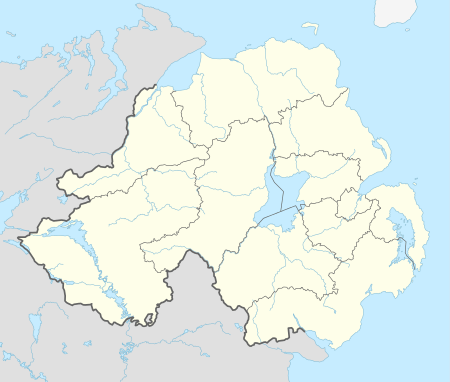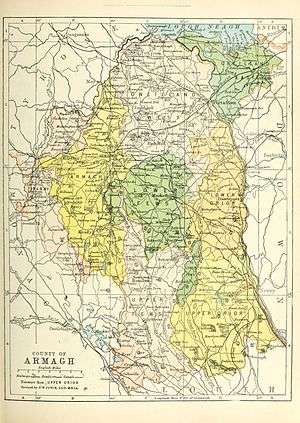Richhill, County Armagh
Richhill or Rich Hill is a large village and townland in County Armagh, Northern Ireland. It lies between Armagh and Portadown. It had a population of 2,821 people in the 2011 Census.[2]
| Richhill | |
|---|---|
 | |
 Location within Northern Ireland | |
| Population | 2,821 (2011 Census) |
| • Belfast | 29 mi (47 km) |
| District | |
| County | |
| Country | Northern Ireland |
| Sovereign state | United Kingdom |
| Post town | Armagh |
| Postcode district | BT61 |
| Dialling code | 028, +44 28 |
| UK Parliament | |
| NI Assembly | |
Originally named Legacorry, it takes its name from Edward Richardson, who built the manor house that the village grew up around.
Origins
At the beginning of the 1600s, the area of Richhill had long been part of the Irish Gaelic territory of Oneilland. In 1610, as part of the Plantation of Ulster, the land was granted to Englishman Francis Sacherevall. His granddaughter Ann married Edward Richardson, who was an English officer, Member of Parliament for County Armagh from 1655–96,[3] and High Sheriff of Armagh in 1665.
Around 1660, Richardson built a manor house on the site that would become Richhill, and in 1664 it was reported that there were twenty houses there.[4] At this time, the village was named Legacorry,[4][5] after the townland in which it sprang up. Legacorry comes from Irish: Log a' Choire, meaning "hollow of the cauldron".[3][5]
In Thomas Molyneux's Journey to the North (1708), the townland appears as "Legacorry, a pretty village belonging to Mr Richardson".[4] It gradually became known as Richardson's Hill and this was shortened to Rich Hill. The original gates to the manor house were wrought by two brothers named Thornberry from Falmouth, Cornwall and were erected in 1745. In 1936 they were moved to the entrance of Hillsborough Castle.[6][7]
Village regeneration
In 2012, it was announced that work would begin on a £1.5 million regeneration scheme, which will transform the village and involve the restoration of about 20 buildings. The Richhill Partnership began work in 2013 with the concealing of over head wires and cables on streets within the conservation area and building restoration work began in early March.[8]
Transport
The Ulster Railway opened Richhill railway station on the line between Belfast and Armagh on 1 March 1848.[9] It was part of the Great Northern Railway from 1876.[10] The Government of Northern Ireland forced the GNR Board to close the line on 1 October 1957.[11]
Portadown is the nearest station run by Northern Ireland Railways with trains to Belfast Great Victoria Street and the Enterprise direct to Belfast Lanyon Place in the east and south to Newry and Dublin Connolly. There are proposals to reopen railway lines in Northern Ireland including the line to Armagh.[12]
Sport
- Broomhill F.C.
- Richhill F.C.
- Richhill Recreation Centre[13]
- Orchard Wheelers Cycling Club
- Armagh and Richhill Beagles[14]
- Lodge Equine Stables and Pony Club Centre[15]
- Intouch Equestrian and Richhill Pony Club Centre[16]
- Richhill Raiders Volleyball Club
Churches
- St Matthew's Church of Ireland
- Richhill Methodist Church
- Richhill Presbyterian Church[17]
- Quakers, The Society of Friends Richhill[18]
- Richhill Elim Church
- Richhill Evangelical Presbyterian Church
- Grace Community Church[19]
Education
- Hardy Memorial Primary School
Notable people
- Richard Best, judge
- William Richardson, Member of Parliament
- Max Clendinning, architect
Demography
2011 Census
It had a population of 2,821 people (1,076 households) in the 2011 Census.[2]
2001 census
The NI Statistics and Research Agency (NISRA) classifies Richhill as an intermediate settlement (i.e. with population between 2,250 and 4,500 people). On Census day (29 April 2011) there were 2,818 people living in Richhill. Of these:
- 2.8% were aged under 16 years and 92.1% were aged 16 and over
- 49.8% of the population were male and 50.3% were female
- 3.4% were from a Catholic background and 94.6% were from a Protestant background
- 11.9% of people aged 16–74 were unemployed[20]
See also
| Wikimedia Commons has media related to Richhill, County Armagh. |
References
- Rich Hill/Log a' Choire. Placenames Database of Ireland.
- "Richhill". Census 2011 Results. NI Statistics and Research Agency. Retrieved 30 April 2015.
- Place Names NI
- T.G.F. Paterson & Emyr Estyn Evans. Harvest Home: A selection from the writings of T. G. F. Paterson relating to County Armagh. Armagh County Museum, 1975. pp. 155-156
- Art J. Hughes & William Nolan. Armagh: History & Society. Geography Publications, 2001. p. 317
- "Give Richhill back its gates says UTV man". Portadown Times. Retrieved 18 July 2015.
- "Dying man wants castle gates back". BBC. Retrieved 18 July 2015.
- "Armagh City, Banbridge and Craigavon Borough Council – Regeneration Projects". Armagh.gov.uk. Retrieved 22 July 2015.
- Hajducki, S. Maxwell (1974). A Railway Atlas of Ireland. Newton Abbott: David & Charles. map 8. ISBN 0-7153-5167-2.
- Hajducki, op. cit., page xiii
- Baker, Michael H.C. (1972). Irish Railways since 1916. London, UK: Ian Allan. pp. 153, 207. ISBN 0 7110 0282 7.
- "New lines proposed in Northern Ireland rail plan". railjournal.com. 3 May 2014.
- Karen McCaffrey (6 March 2014). "Armagh City, Banbridge and Craigavon Borough Council – Richhill Recreation Centre to host National Indoor Bowls Championship finals". Armagh.gov.uk. Retrieved 22 July 2015.
- "Armagh and Richhill Beagles". Bailyshuntingdirectory.com. Retrieved 22 July 2015.
- "Pony Club". Lodge Equine Stables. Retrieved 22 July 2015.
- "Centres of The Pony Club". Pcuk.org. Retrieved 22 July 2015.
- "Richhill Presbyterian". Richhillpc.org.uk. Retrieved 22 July 2015.
- "Richhill | Quakers in Ireland". Quakers-in-ireland.ie. Retrieved 22 July 2015.
- "Rise 2015". Grace-community.church. Retrieved 22 July 2015.
- "NINIS Home Page". Ninis.nisra.gov.uk. 2 July 2015. Retrieved 22 July 2015.
